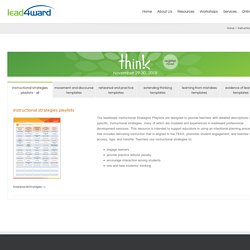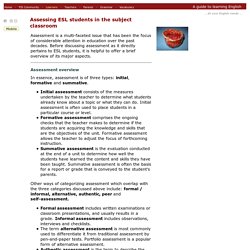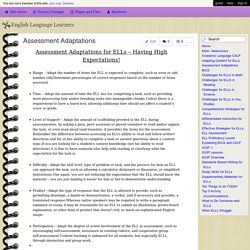

Strategies and Tools for Assessing ELs. Assessment. Assessment of English Language Learners. Choose the Learning Mistakes Tab. Movement and discourse templates Learning is activated when kids are moving and talking.

Movement provides the opportunity for learners to become actively engaged and talk to each other in a variety of group sizes. Get them moving every 18-20 minutes. rehearsal and practice templates Learning requires rehearsal and practice. Extending thinking templates Learning requires thinking. Learning from mistakes templates Learning is assessed in a variety of ways on high stakes tests. Evidence of learning templates Learning is best assessed in multiple measures – tests, products, discourse, and other formative and summative assessment methods. Assessment for ELLs in the Classroom. Larry Ferlazzo - Assessing English language learners. State Methods to Identify ELLs. Every Teacher’s Guide to Assessment. It’s not a stretch to say that assessment is a hot button issue in education; however, you’d be hard pressed to find an educator who doesn’t see the value in measuring student progress.
Assessments themselves have been vilified, when, in fact, it’s why assessments are given and how the data is used that is really the issue. The Glossary of Education Reform gives this great overview of what high-stakes testing is and how it impacts students, teachers, and schools. Basically, high-stakes testing has consequences for the test-takers and givers—sometimes in the form of a high school diploma, grade advancement, and even teachers’ salaries. But not all assessment is high-stakes, and when done thoughtfully, the right assessment can provide extremely useful information for all stakeholders—students, teachers, parents, schools, and policy-makers Let’s take a look at what assessment is, why it’s important, and how it can be delivered in the classroom in a useful manner.
ESL 3 4 Assessment. Assessing ELLs. The Internet TESLJournal By Laureen A.

Fregeau and Robert D. Leierlfregeau{at}usouthal.edu and rdl0002{at}auburn.eduUniversity of South Alabama (Mobile, Alabama), Auburn University (Auburn, Alabama, USA) Introduction One result of the Lau vs. Nichols 1974 Supreme Court Decision is that students who do not speak English as their first language must be provided instructional and assessment modifications so they have the opportunity to be academically successful (Ovando, Collier, & Combs, 2006). Many (ELLs) are now mainstreamed into regular classrooms.
Taking a test can be a very frustrating experience for an English Language Learner. Fair And Square Assessments for ELLs - Educational Leadership. Classroom assessment. Assessing ESL students in the subject classroom. Assessment is a multi-faceted issue that has been the focus of considerable attention in education over the past decades.

Before discussing assessment as it directly pertains to ESL students, it is helpful to offer a brief overview of its major aspects. Assessment overview In essence, assessment is of three types: initial, formative and summative. Initial assessment consists of the measures undertaken by the teacher to determine what students already know about a topic or what they can do. Initial assessment is often used to place students in a particular course or level. Other ways of categorizing assessment which overlap with the three categories discussed above include: formal / informal, alternative, authentic, peer and self-assessment. Ell guidelines.
ETS Research: English Learner Formative Assessment Project. The English Learner Formative Assessment (ELFA) is a four-year research project that began in 2010.

This project is funded by the Institute of Education Sciences at the U.S. Department of Education (Grant No: R305A100724). In collaboration with the National Center for Research on Evaluation, Standards, & Student Testing (CRESST) at UCLA, a team of researchers and assessment specialists at ETS has worked on the development of a classroom-based, academic reading comprehension assessment tool that teachers can use with their English learners (ELs) for formative purposes.
The ELFA tool: The purpose of this website is to disseminate the ELFA materials as useful resource materials for the teachers of EL students. Use the links above to access all available materials regarding ELFA and to see a selection of sample assessments. Next: ELFA Design Framework > ETS Research: ELFA Assessment Forms. The English Learner Formative Assessment (ELFA) includes a total of nine assessment forms with different levels of reading passages for Developing, Intermediate and Experienced readers.

Each form consists of two reading texts, Part 1 and Part 2. Teachers might select any of the forms that are appropriate to their EL students. Three sample assessment forms — Forms 1, 4 and 8 — are available to download below. The remaining forms are available upon request by sending an email to the project director, Mikyung Kim Wolf (mkwolf@ets.org). Please download the accompanying Teacher's Versions of each form in order to use the assessment forms in your class. Please read the ELFA Teacher's Guide (PDF) before using any of the ELFA assessment forms. The assessment forms cannot be used for commercial purposes without prior approval from ETS. Developing. English Language Learners - Assessment Adaptations.
Skip to main content You are not a member of this wiki.

Join now Dismiss guest. ELL Assessment Pinterest.
Feedback and Error Correction. EL Formative Assessment.